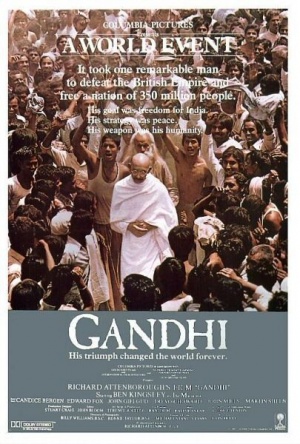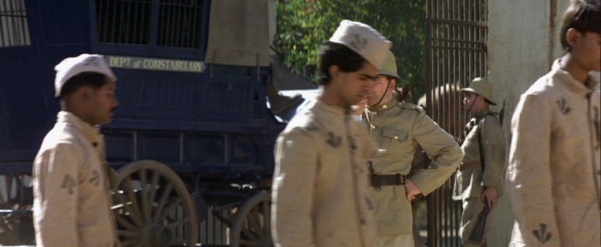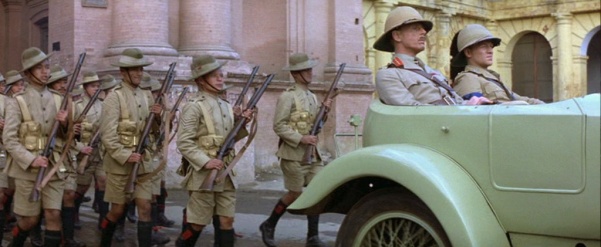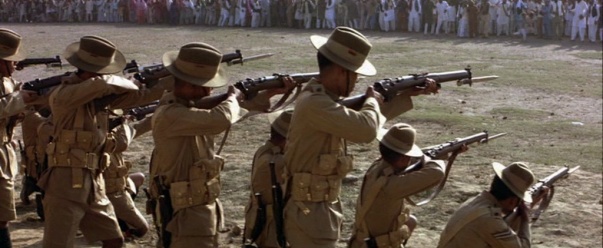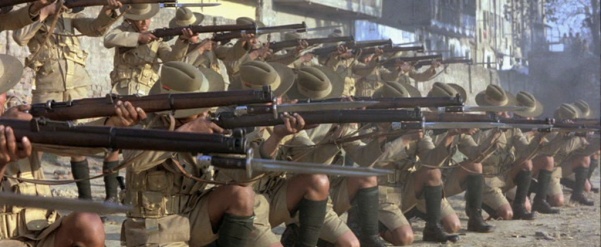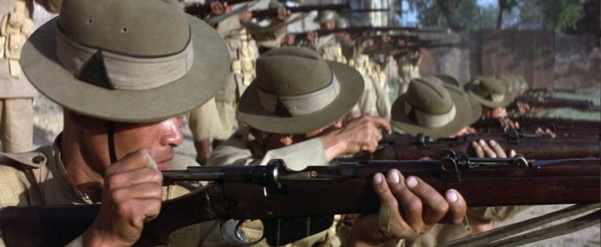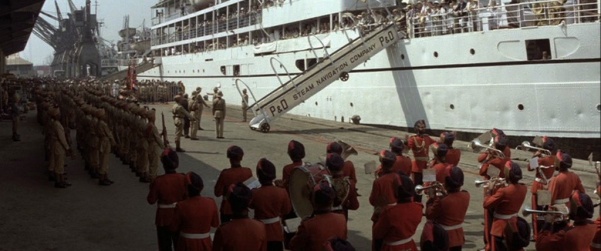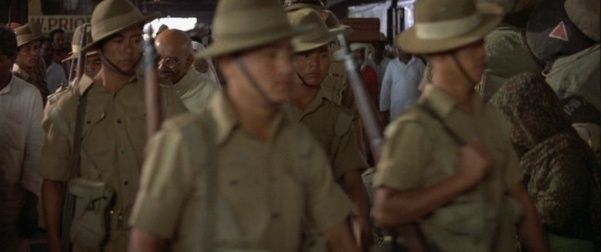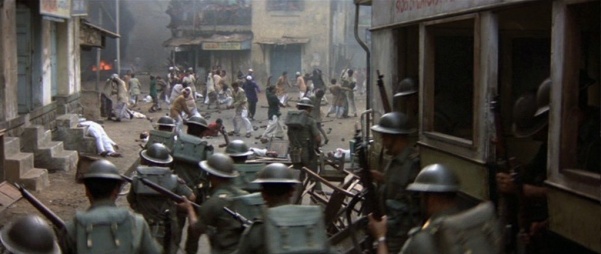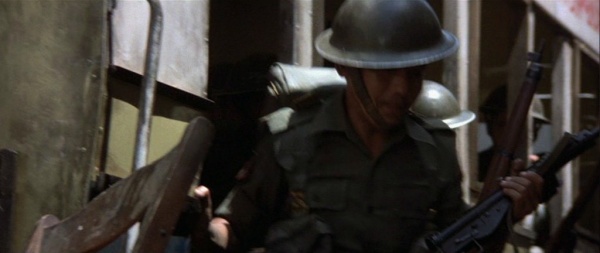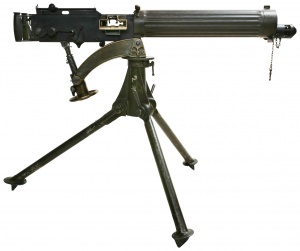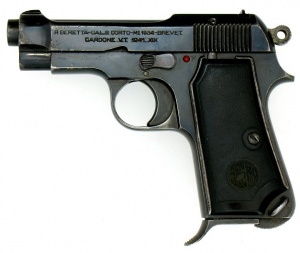| If you have been locked out of your account you can request a password reset here. |
Difference between revisions of "Gandhi"
| (17 intermediate revisions by 8 users not shown) | |||
| Line 1: | Line 1: | ||
| − | + | [[Image:Gandhimovie.jpg|thumb|right|300px|''Gandhi'' (1982)]] | |
| − | ''' | + | '''''Gandhi''''' is a 1982 biographical drama detailing the life of Mahatma Gandhi and his role in campaigning for the freedom of India from British rule. Directed by [[Richard Attenborough]], the film follows Gandhi ([[Ben Kingsley]]) from his days as a young lawyer fighting government repression of Indian workers in South Africa to his campaigns of nonviolent resistance against the British in India, culminating with the nation's independence in 1947. |
| − | [[ | + | ''Gandhi'' would later be nominated for eleven Academy Awards and was the winner of eight, including for Best Picture, Best Director, and Best Actor for [[Ben Kingsley]]. |
| + | |||
| + | {{Film Title}} | ||
| + | __TOC__<br clear=all> | ||
| − | + | {{Spoilers}} | |
| − | |||
| − | |||
| − | |||
==Martini-Henry Rifle== | ==Martini-Henry Rifle== | ||
Whilst Gandhi is spending some time in a South African prison, guards in the background are seen armed with [[Martini-Henry Rifle Series|Martini-Henry]] rifles. Whilst the exact model of the rifles featured is difficult to make out, the length of the operating leaver would suggest that they are no later than Mk. III variants. The Mk. IV model that followed was characterised by a longer lever which aided the extraction of cartridges. | Whilst Gandhi is spending some time in a South African prison, guards in the background are seen armed with [[Martini-Henry Rifle Series|Martini-Henry]] rifles. Whilst the exact model of the rifles featured is difficult to make out, the length of the operating leaver would suggest that they are no later than Mk. III variants. The Mk. IV model that followed was characterised by a longer lever which aided the extraction of cartridges. | ||
[[Image:Martini-HenryMarkIII(1881-1888).jpg|thumb|none|500px|Martini-Henry Mk. III, .577-.450 caliber.]] | [[Image:Martini-HenryMarkIII(1881-1888).jpg|thumb|none|500px|Martini-Henry Mk. III, .577-.450 caliber.]] | ||
| − | [[Image:Martinigandhi.jpg|thumb|none| | + | [[Image:Martinigandhi.jpg|thumb|none|601px|A guard opens the prison gates with his Martini-Henry slung across his shoulder.]] |
== Short Magazine Lee-Enfield (SMLE) == | == Short Magazine Lee-Enfield (SMLE) == | ||
| − | The [[Short Magazine Lee-Enfield (SMLE) | + | The [[Short Magazine Lee-Enfield]] (SMLE) is seen throughout the film in the hands of British and Indian soldiers as well as Gurkhas recruited from Nepal. Given that the film was shot mainly in India, most of these Lee-Enfields are likely to have been built or at least refurbished in India at the factory in Ishapore. Some examples can be seen with squared-off foresight protectors which confirm this. |
[[Image:SMLE.jpg|thumb|none|450px|.303 SMLE Mk. III.]] | [[Image:SMLE.jpg|thumb|none|450px|.303 SMLE Mk. III.]] | ||
| − | [[Image:SMLE1.jpg|thumb|none| | + | [[Image:SMLE1.jpg|thumb|none|601px|Reverend Charlie Andrews is confronted by an SMLE-carrying soldier whilst visiting Gandhi in jail.]] |
| − | [[Image:SMLE2.jpg|thumb|none| | + | [[Image:SMLE2.jpg|thumb|none|601px|Gurkhas march through the streets of Amritsar with SMLEs at the port.]] |
| − | [[Image:SMLE4.jpg|thumb|none| | + | [[Image:SMLE4.jpg|thumb|none|603px|Gurkhas take aim at the crowd gathered illegally in Jallianwala Bagh. The bayonets fitted to their rifles seem to be shorter than the standard 17" 1907 pattern bayonet. These are either cut-down examples or one of the many shorter Indian-made patterns.]] |
| − | [[Image:SMLE7.jpg|thumb|none| | + | [[Image:SMLE7.jpg|thumb|none|601px|The command is given to open fire resulting in the infamous massacre that took place on April 13, 1919.]] |
| − | [[Image:SMLE6.jpg|thumb|none| | + | [[Image:SMLE6.jpg|thumb|none|601px|A Gurkha cycles the bolt of his SMLE. A crimp-nosed blank can be seen about to be chambered.]] |
| − | [[Image:SMLE8.jpg|thumb|none| | + | [[Image:SMLE8.jpg|thumb|none|601px|Piles of empty .303 cases build up. Around 1650 rounds were fired causing an estimated 1500 casualties. The estimated number of deaths ranges from around 300 to over 1000.]] |
== Lee-Enfield No. 4 == | == Lee-Enfield No. 4 == | ||
| − | Some soldiers can be seen with [[ | + | Some soldiers can be seen with [[Lee-Enfield No. 4 Mk I|Lee-Enfield No. 4]] rifles. Even after the introduction of the No. 4, production of SMLEs continued in India where they can still be found in the hands of police forces. No. 4 rifles were not built in India but were produced in Pakistan post-independence. |
[[Image:LeeEnfield4Rifle.jpg|thumb|none|450px|.303 Lee-Enfield No.4 Mk. I. ]] | [[Image:LeeEnfield4Rifle.jpg|thumb|none|450px|.303 Lee-Enfield No.4 Mk. I. ]] | ||
| − | [[Image:No41.jpg|thumb|none| | + | [[Image:No41.jpg|thumb|none|601px|When Gandhi disembarks from the ship which has brought him back to India from South Africa, a new governor-general is greeted by a guard of honor armed with No. 4 rifles. This is an anachronism since this scene takes place in 1915 and the No. 4 was not fully adopted into service until 1941.]] |
| − | [[Image:No42.jpg|thumb|none| | + | [[Image:No42.jpg|thumb|none|601px|Gurkhas escort Gandhi away after his arrest in 1942. The No. 4 was not issued in great numbers in the Asian and Pacific theatres of the Second World War until later on, the bulk seeing service in Europe, so it is surprising that all the soldiers in this scene are carrying No. 4 rifles.]] |
| − | [[Image:No43.jpg|thumb|none| | + | [[Image:No43.jpg|thumb|none|601px|Indian sailors parade for Lord Louis Mountbatten as he arrives as Viceroy in 1947.]] |
| − | [[Image:No44.jpg|thumb|none| | + | [[Image:No44.jpg|thumb|none|601px|Gurkhas attempt to keep civil order during clashes between Hindus and Muslims shortly after Indian independence is granted.]] |
| − | ==Sten Mk | + | ==Sten Mk II Submachine Gun== |
| − | A [[Sten]] can be seen in the hands of a Gurkha during attempts to disperse rioters. The Sten provided a cheap alternative to the Thompson submachine gun which the British and commonwealth forces had been importing since the start of WWII. A simple design, although not without issues, the Sten remained in service throughout and beyond. A similar design, the Sterling, would go on to replace the Sten as the submachine gun of the British Army and would be used until the late 1980s. | + | A [[Sten Mk II]] can be seen in the hands of a Gurkha during attempts to disperse rioters. The Sten provided a cheap alternative to the Thompson submachine gun which the British and commonwealth forces had been importing since the start of WWII. A simple design, although not without issues, the Sten remained in service throughout and beyond. A similar design, the Sterling, would go on to replace the Sten as the submachine gun of the British Army and would be used until the late 1980s. |
[[Image:Unitsten2.jpg|thumb|none|400px|Sten Mk II Submachine gun, 9x19mm.]] | [[Image:Unitsten2.jpg|thumb|none|400px|Sten Mk II Submachine gun, 9x19mm.]] | ||
| − | [[Image:Stengandhi.jpg|thumb|none|600px|A Gurkha armed with a Sten Mk | + | [[Image:Stengandhi.jpg|thumb|none|600px|A Gurkha armed with a Sten Mk II.]] |
==Vickers Machine Gun== | ==Vickers Machine Gun== | ||
| − | During the scene centered around the Amritsar massacre, a mock-up of a Rolls-Royce | + | During the scene centered around the Amritsar massacre, a mock-up of a Rolls-Royce armored car is featured. The traditional armament of these vehicles were [[Vickers]] machine guns, although later models of the vehicle were given heavier weapons. The machine gun mounted on the car in the film seems to be a mock-up also, as it does not resemble any specific design. It is therefore assumed that this is intended to represent a Vickers. Since the gates of the Jallianwala Bagh garden were too narrow to allow an armored car to enter, the Vickers could not be brought to bear on the crowd. |
[[Image:Vickers gun.JPG|thumb|none|300px|.303 Vickers Mk. I.]] | [[Image:Vickers gun.JPG|thumb|none|300px|.303 Vickers Mk. I.]] | ||
| − | [[Image:Vickers1.jpg|thumb|none| | + | [[Image:Vickers1.jpg|thumb|none|601px|A Vickers stand-in mounted on the armored car.]] |
| − | [[Image:Vickers2.jpg|thumb|none| | + | [[Image:Vickers2.jpg|thumb|none|601px|The mock-up armored car followed by a contingent of Indian soldiers and Gurkhas. A version of the Rolls-Royce armoured car was produced with a domed turret and additional machine gun mountings for service in India]] |
| + | |||
| + | ==Beretta Model 1934== | ||
| + | Nathuram Godse ([[Harsh Nayyar]]) infamously used a [[Beretta M1934]] on January 30 1948, firing three times at Gandhi at close range. This event is featured in both the opening and closure of the film. | ||
| + | [[Image:Beretta Model 1934 Pistol.jpg|thumb|none|300px|Beretta Model 1934, .380 ACP.]] | ||
| + | [[Image:Berettagandhi.jpg|thumb|none|601px|Godse unleashes a volley of shots with his M1934 Beretta.]] | ||
| + | |||
[[Category:Movie]] | [[Category:Movie]] | ||
[[Category:Drama]] | [[Category:Drama]] | ||
| + | [[Category:Biographical Movie]] | ||
[[Category:British Produced/Filmed]] | [[Category:British Produced/Filmed]] | ||
| + | [[Category:Academy Award Best Picture]] | ||
Latest revision as of 01:52, 18 December 2019
Gandhi is a 1982 biographical drama detailing the life of Mahatma Gandhi and his role in campaigning for the freedom of India from British rule. Directed by Richard Attenborough, the film follows Gandhi (Ben Kingsley) from his days as a young lawyer fighting government repression of Indian workers in South Africa to his campaigns of nonviolent resistance against the British in India, culminating with the nation's independence in 1947. Gandhi would later be nominated for eleven Academy Awards and was the winner of eight, including for Best Picture, Best Director, and Best Actor for Ben Kingsley.
The following weapons were used in the film Gandhi:
![]() WARNING! THIS PAGE CONTAINS SPOILERS!
WARNING! THIS PAGE CONTAINS SPOILERS!
Martini-Henry Rifle
Whilst Gandhi is spending some time in a South African prison, guards in the background are seen armed with Martini-Henry rifles. Whilst the exact model of the rifles featured is difficult to make out, the length of the operating leaver would suggest that they are no later than Mk. III variants. The Mk. IV model that followed was characterised by a longer lever which aided the extraction of cartridges.
Short Magazine Lee-Enfield (SMLE)
The Short Magazine Lee-Enfield (SMLE) is seen throughout the film in the hands of British and Indian soldiers as well as Gurkhas recruited from Nepal. Given that the film was shot mainly in India, most of these Lee-Enfields are likely to have been built or at least refurbished in India at the factory in Ishapore. Some examples can be seen with squared-off foresight protectors which confirm this.
Lee-Enfield No. 4
Some soldiers can be seen with Lee-Enfield No. 4 rifles. Even after the introduction of the No. 4, production of SMLEs continued in India where they can still be found in the hands of police forces. No. 4 rifles were not built in India but were produced in Pakistan post-independence.
Sten Mk II Submachine Gun
A Sten Mk II can be seen in the hands of a Gurkha during attempts to disperse rioters. The Sten provided a cheap alternative to the Thompson submachine gun which the British and commonwealth forces had been importing since the start of WWII. A simple design, although not without issues, the Sten remained in service throughout and beyond. A similar design, the Sterling, would go on to replace the Sten as the submachine gun of the British Army and would be used until the late 1980s.
Vickers Machine Gun
During the scene centered around the Amritsar massacre, a mock-up of a Rolls-Royce armored car is featured. The traditional armament of these vehicles were Vickers machine guns, although later models of the vehicle were given heavier weapons. The machine gun mounted on the car in the film seems to be a mock-up also, as it does not resemble any specific design. It is therefore assumed that this is intended to represent a Vickers. Since the gates of the Jallianwala Bagh garden were too narrow to allow an armored car to enter, the Vickers could not be brought to bear on the crowd.
Beretta Model 1934
Nathuram Godse (Harsh Nayyar) infamously used a Beretta M1934 on January 30 1948, firing three times at Gandhi at close range. This event is featured in both the opening and closure of the film.
